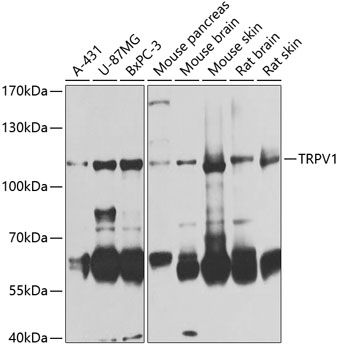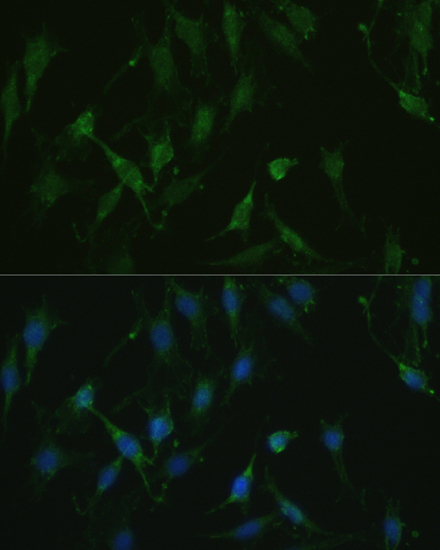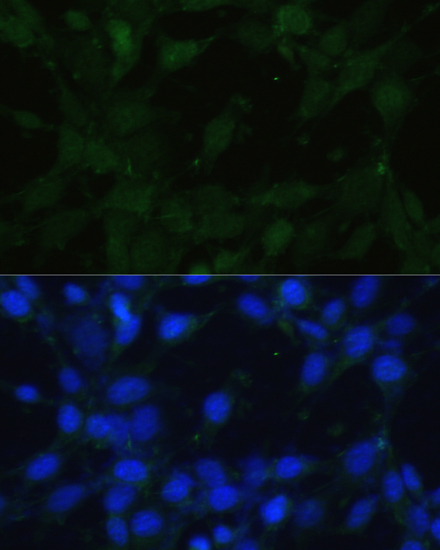-
Product Name
TRPV1 Polyclonal Antibody
- Documents
-
Description
Polyclonal antibody to TRPV1
-
Tested applications
WB, IF
-
Species reactivity
Human, Mouse, Rat
-
Alternative names
TRPV1 antibody; VR1 antibody; transient receptor potential cation channel subfamily V member 1 antibody
-
Isotype
Rabbit IgG
-
Preparation
Antigen: A synthetic peptide corresponding to a sequence within amino acids 400-500 of human TRPV1 (NP_061197.4).
-
Clonality
Polyclonal
-
Formulation
PBS with 0.02% sodium azide, 50% glycerol, pH7.3.
-
Storage instructions
Store at -20℃. Avoid freeze / thaw cycles.
-
Applications
WB 1:500 - 1:2000
IF 1:50 - 1:200 -
Validations

Western blot - TRPV1 Polyclonal Antibody
Western blot analysis of extracts of various cell lines, using TRPV1 antibody at 1:1000 dilution.Secondary antibody: HRP Goat Anti-Rabbit IgG (H+L) at 1:10000 dilution.Lysates/proteins: 25ug per lane.Blocking buffer: 3% nonfat dry milk in TBST.Detection: ECL Basic Kit .Exposure time: 60s.

Immunofluorescence - TRPV1 Polyclonal Antibody
Immunofluorescence analysis of C6 cells using TRPV1 antibody at dilution of 1:100. Blue: DAPI for nuclear staining.

Immunofluorescence - TRPV1 Polyclonal Antibody
Immunofluorescence analysis of NIH/3T3 cells using TRPV1 antibody at dilution of 1:100. Blue: DAPI for nuclear staining.

Immunofluorescence - TRPV1 Polyclonal Antibody
Immunofluorescence analysis of U2OS cells using TRPV1 antibody at dilution of 1:100. Blue: DAPI for nuclear staining.
-
Background
Ligand-activated non-selective calcium permeant cation channel involved in detection of noxious chemical and thermal stimuli. Seems to mediate proton influx and may be involved in intracellular acidosis in nociceptive neurons. Involved in mediation of inflammatory pain and hyperalgesia. Sensitized by a phosphatidylinositol second messenger system activated by receptor tyrosine kinases, which involves PKC isozymes and PCL. Activation by vanilloids, like capsaicin, and temperatures higher than 42 degrees Celsius, exhibits a time- and Ca(2+)-dependent outward rectification, followed by a long-lasting refractory state. Mild extracellular acidic pH (6.5) potentiates channel activation by noxious heat and vanilloids, whereas acidic conditions (pH <6) directly activate the channel. Can be activated by endogenous compounds, including 12-hydroperoxytetraenoic acid and bradykinin. Acts as ionotropic endocannabinoid receptor with central neuromodulatory effects. Triggers a form of long-term depression (TRPV1-LTD) mediated by the endocannabinoid anandamine in the hippocampus and nucleus accumbens by affecting AMPA receptors endocytosis.
Related Products / Services
Please note: All products are "FOR RESEARCH USE ONLY AND ARE NOT INTENDED FOR DIAGNOSTIC OR THERAPEUTIC USE"
